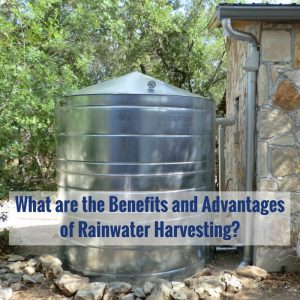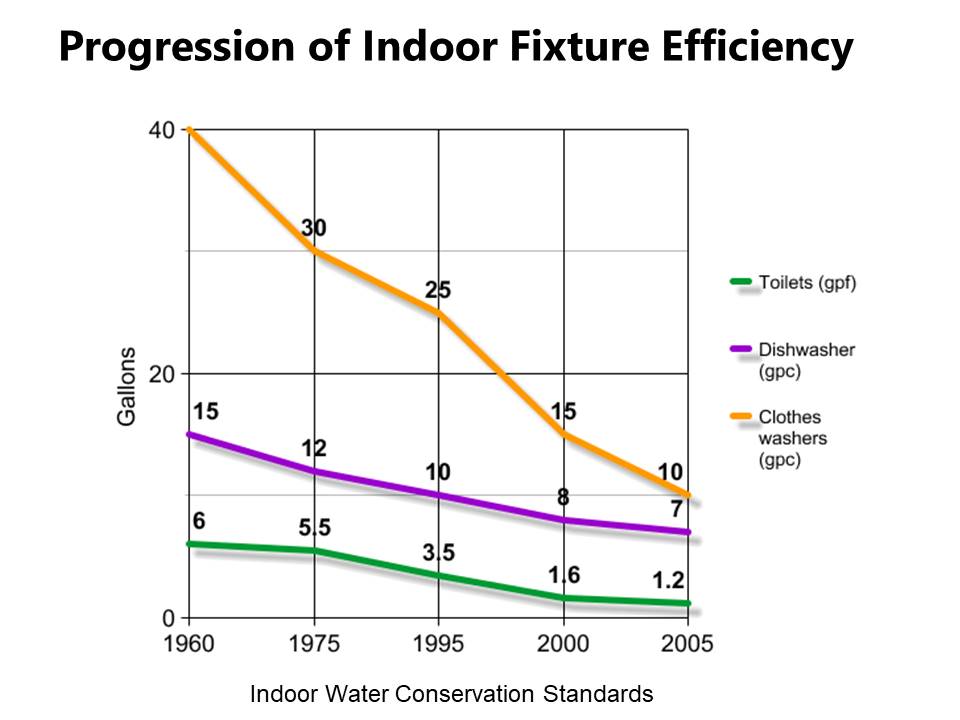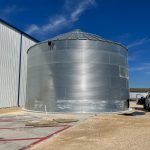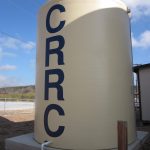 Rainwater harvesting has many benefits but the main one is that it is a sustainable water management practice that can be implemented by anyone on many different levels, from a simple rain barrel to a comprehensive rainwater harvesting system that integrates with an irrigation system or household plumbing.
Rainwater harvesting has many benefits but the main one is that it is a sustainable water management practice that can be implemented by anyone on many different levels, from a simple rain barrel to a comprehensive rainwater harvesting system that integrates with an irrigation system or household plumbing.
When you think about it… do we need to use municipally treated water to sprinkle on our lawns and landscaping? Definitely not! Harvested rainwater is the perfect candidate for irrigation use in addition to so many other water uses. By using rainwater harvesting systems to supply water for some, or all of our water needs, you can reduce our dependence on municipally treated water.
Overall, rainwater harvesting is viewed as a practice that is socially acceptable and environmentally responsible all the while, promoting self-sufficiency.
The Water Conservation Benefits of Rainwater Harvesting
- The rainwater that falls on your roof and property is essentially free. All it takes is a method to harvest it into a tank or cistern for later use.
- Rainwater harvesting can be a great educational tool to get people to recognize their individual or household water usage. This can get them to start conserving water in other areas around their home.
- For communities that rely on imported water to supply their needs, collecting rainwater that falls naturally in the community can reduce the need for imported water.
- Rainwater harvesting helps utilities reduce peak demands during summer months, saving treated water for more important and appropriate water uses.
- While rainwater can be a perfect primary water source for many uses and situations, it is also a great backup water supply for emergency situations.
The Environmental Benefits of Rainwater Harvesting
- Rainwater harvesting can reduce stormwater runoff from a property. The elimination of runoff can reduce contamination of surface water with pesticides, sediment, metals, and fertilizers.
- By reducing stormwater runoff, rainwater harvesting can reduce a storm’s peak flow volume and velocity in local creeks, streams, and rivers, thereby reducing the potential for streambank erosion.
- Rainwater harvesting systems can be employed as simple and effective methods to meet a municipality’s stormwater management program requirements of individual properties.
- It is an excellent source of water for plants and landscape irrigation since it has no chemicals such as fluoride and chloramines (chlorine).
The Water-Energy Nexus Benefits of Rainwater Harvesting
While the logical use of rainwater harvesting is for water conservation purposes, it also reduces energy use within a community.
- Typically, the end use of the rainwater is located on the property where the rainwater is collected. Replacing municipal water use at a home and property with rainwater reduces the amount of water that a municipality has to treat and then pump to your house. The treatment and pumping of municipally provided water require a lot of energy.
- The implementation of rainwater harvesting can help meet new standards of energy and water efficiency ratings and codes that are being developed in communities.
The traditional path of rainwater through our local water ecosystem and how it gets to our homes:
 The simplified path available through the implementation of rainwater harvesting:
The simplified path available through the implementation of rainwater harvesting:
 The Economic Benefits of Rainwater Harvesting
The Economic Benefits of Rainwater Harvesting
- Collecting and using rainwater to replace municipal water use reduces your water bill
- Reducing municipal water use for areas such as irrigation reduces the amount of water that a municipality has to treat and pump. This, in turn, reduces water service cost to a municipality.
- The widespread implementation of rainwater harvesting within a municipality’s service area can reduce the long-term water development needs of a city, allowing the city to use their existing water infrastructure investments more efficiently. The cost to the community to supply treated water is becoming more expensive every year. The cost to construct dams, pipes, and treatment plants, not to mention the cost of maintenance and infrastructure replacement is huge. As water users, the rate-payers in the community ultimately will foot this rising bill. Therefore, the practice of rainwater harvesting can reduce water demand and thus allow municipalities to provide potable water service at a lower cost.
- Designing and installing rainwater collection systems can provide sustainable jobs for the economy of the future. The rainwater harvesting industry can become a leading employer in the green infrastructure movement.
- Rainwater stored onsite in a rainwater harvesting system can be available for wildfires and help protect the house and property. Insurance companies can offer discounts for storing water onsite for fire protection.
The Ancillary Benefits of Rainwater Harvesting
- Rainwater can be used for irrigation use, indoor non-potable water use, and/or potable water supply.
- Rainwater harvesting can provide an independent water source in areas where other water sources are unavailable, or the water quality is unacceptable, or they are too expensive to develop, or they are too difficult to obtain.
- If used as a potable water source, the zero hardness of rainwater provides many advantages. It eliminates the scale build-up in household appliances that could occur with the use of other water sources. This will extend the life of the appliances. In addition, it reduces the amount of detergent or soaps needed in laundry and dishwashing appliances, reducing money spent on these detergents and soaps.
- Rainwater from a potable rainwater harvesting system that has been properly filtered and disinfected is some of the best tasting water available. It doesn’t have the many chemicals that municipally treated water has such as fluoride or chloramines (chlorine).
Rainwater Harvesting is the Key to Future Water Conservation Gains
Ever since the US government enacted national standards in the U.S. Energy Policy Act of 1992 and set minimum efficiency standards for all toilets, showers, urinals and faucets manufactured in the United States, the opportunities for indoor water conservation has decreased. During this time, outdoor water use efficiency standards have somewhat been neglected. Therefore, rainwater harvesting provides a tremendous opportunity to achieve more water conservation gains at each and every residential and commercial property.
Real Water Conservation Gains Require Active Use
You see this statement everywhere, even in the list of benefits above: “Rainwater harvesting will help conserve water and reduce municipal water use.” While it will do these things, just installing a rain barrel or rainwater cistern under a downspout, won’t accomplish much. There is a key component that is missing… having a strategy or method to use all of the collected rainwater in an efficient manner.
If the harvested rainwater is not used efficiently, then the rain barrel or tank will essentially stay full. Then the new rainwater from each rain storm will just overflow the storage volume and provide no water conservation benefit.
Therefore, a truly effective rainwater harvesting system employs a method to use the harvested rainwater in a timely manner. This could be accomplished through both passive and active methods. A passive method could use a distribution system that automatically distributes rainwater by gravity through a distribution pipe or tubing system. An active method would be through a pump system that can pressurize the rainwater into an automated irrigation system.
Without thinking about how you will use the harvested rainwater, the practice of rainwater harvesting loses its impact.
Rainwater Harvesting is Vital for the Future of Sustainable Water Resources
As you can see from the benefits and advantages listed above, the practice of rainwater harvesting is an important and vital part of developing a sustainable water resource path for any community. As local water resources are stretched to provide for population growth and economic development, new water supply strategies and paradigms will be necessary to meet this demand. Rainwater harvesting is an untapped resource that could be developed quickly within communities and that will also have a tremendous impact. Rainwater harvesting is part of a sustainable water supply strategy for local communities.







Thnx
Hello Chris,
Happy to see this about conserving water. However, I have a doubt in my mind that can you explain me “how can I conserve water for summer use? Means, How the rainwater can be stored for long purpose as summer will start after 8 months”
It all comes down to the volume of your storage container. If you install a tank large enough to provide for your short-term usage but also to ensure you have extra left for the drier months, then you can have water for summer use. Rainwater in an opaque container that doesn’t allow sunlight in, can actually keep for a very long time. Sunlight in rainwater produces algae and ruins the water or at least makes it more difficult to use from the container. So it comes down to installing as large of a tank that you possibly can.
HI My Name Is Nicholas Penaloza Can You Please Make It Rain Heavy In Oxnard CA Right Now Please
Nicholas… I wish I could… if I had that ability then I would be a rich man. LOL
Hello Chris,
Your information about the rainwater harvesting system helps me a lot in my project that I am working on, but I want to know that in which location people uses rainwater harvesting system the most
Leo, rainwater harvesting is a great sustainable technique that really can be employed anywhere. People say that harvesting rainwater in areas of low rainfall is not very helpful but I disagree. In those areas, every rain drop is precious. Other people say that harvesting rainwater in areas of high rainfall is useless since it rains so much. In these areas though, developing other water sources may be more costly than rainwater harvesting. Therefore, it can be employed anywhere in the world.
Hello Sir I am a school going children I have to make a project on how rainwater harvesting is essential.. I have to make a report in this topic but sir the doubt is that can we make this project in an area where rain fall is less and if we can make so how it will conserve more and more rain water
Thank you for the question! In my opinion, I think rainwater harvesting is useful in any climate (other than a desert but I could make the case). It really comes down to the investment level for the rainwater harvesting system. In areas of lower rainfall, you want to create a system that is affordable and fits the potential water collection opportunity. Meaning, you don’t want to design and install an expensive, complicated, large system if you won’t be able to collect much rainwater since you are limited by the amount of rain that falls in your area. So just create a system that is appropriate to the potential rainfall amounts in your area and you will be doing good.
The reason 60% of human population go to bed with empty stomach is the lack of water to produce food and it rains once every four months how are we going to get the water we need….for water is illusive and requires order application to the highest level of participation: capturecontain managemaintain water use for food production programs are expected to be more than expected to reach out to the community projects in a bid to help boost our environment by recycling right now
Hi Chris, great article! I’m interested in determining the financial benefits of rainwater harvesting for large systems (ie ~ 500,000 gallons) in terms of avoided maintenance and reduced burden on a city’s gray infrastructure. Do you think there are any ways to calculate those kinds of benefits and factor it into a ROI of sorts? I’m interested in your response!
Ian, thanks for the question!
You have asked a question which would require some smart academics or consulting firm people to dig into. I don’t have any real answer off the top of my head other than that I know that larger scale rainwater harvesting systems would DEFINITELY have a great impact of avoided maintenance for a city’s infrastructure. It may not affect the piping infrastructure (pressurized supply and wastewater piping since water would be going through these pipes anyway, but it would definitely affect the water treatment infrastructure. Theoretically, the treatment infrastructure would have to treat less water, thus prolonging the life and extending the anticipated maintenance on this infrastructure.
So how to go about calculating those benefits? One simple way may be to figure out the cost to run a water treatment plant per gallon of water treated. Then once you know how much water you would save through the use of harvested rainwater, you could come up with a good cost of the benefit of a large-scale rainwater harvesting system to a municipal infrastructure system.
Hopefully this has pointed you in the right direction.
Chris
Thank you so much for your grand initiative on this topic sir!! This is the kind of opportunities I have Benn looking for for the gone years, in fact you are imparting so much knowledge to us rainwater harvesting. The citation link link please, how can I cute you? Thank you so much
Hello Chris,
I myself am a Civil engineer and wanted to make a blog about benefits and techniques of rainwater harvesting. Reading your post has really enlighten me, but I would like to ask you about harvesting rainwater in an open well. It is a common practise where I live, but I have seen that when it rains, and the water id put into the well, the water in the well becomes muddy and cannot be used immediately but only after allowing the soil particles to settle. When this well is the only source of water for the house, most people shy away from this practise, especially if they personally do not have to face water shortage issues. Would you take sometime to explain how this problem can be solve?
Thanks.
Foustin, thanks for your question. I have heard about using rainwater from roof surfaces to recharge wells in places like India but it is not a practice used in the US. I think it would be difficult to keep the water in the well from becoming muddy if you let rainwater, say from a pipe off a gutter, go directly into the well. The only way to do that would be to calm the water before letting it enter the well. If you discharge the water below the water surface of the well, that could dissipate some of the incoming energy and allow less dirt to be kicked up in the well. But in the end, this is just a guess for me.
Good luck!
Hello sir I am a school going kid. As HHW I got a project stating Catch The Rain Where It Falls, When It Falls. In this project I have to make a model showing rainwater harvesting. So I thought of making Roof top rainwater harvesting. Here I have another choice stating – Model of Retention Ponds Rainwater Harvesting. Which to opt? Pls advise.
I think creating a roof top rainwater harvesting model would be a little be easier to make and model versus a retention pond model. All you need is a roof structure with some gutters that channel the rainwater into a rainwater tank. Voilà! Good luck with your project!
Hi Chris,
I am an engineering geologist from Turkey. I wonder that, if it is possible the harvesting rainwater to transfer into the soil directly? If your answer is yes, could you please explain, are there any disadvanteges for the foundation of the buildings?
Thank you
Berna, I’m not exactly sure what you mean but I will take a shot at answering. If you are inquiring about allowing rainwater to flow off of structures and directly transfer it to soil for infiltration, it can be done but due to the quantity of runoff and the long time that soil infiltration can require, you will still need a reservoir of sorts to temporarily hold the excess rainwater before it can transfer to the soil and infiltrate. So you can develop a “dry well” system which is basically a large container that is buried underground that has no bottom. Collected rainwater could build up in the dry well as the soil is catching up in terms of infiltration. A system like this could be fine next to buildings especially if the bottom of the dry well is below the bottom of the foundation.
Hopefully this provides some good information for you.
Thanks for the question!
Hi,
Doing some research on water catchment for my own home, but also looking into price breaks on municipal water for people in my coastal town that utilize catchment. I see the upsides but what might be the downsides ecologically speaking, of capturing water that would otherwise recharge the groundwater? How does catchment affect the larger landscape?
Cynthia, GREAT QUESTION!! This question comes up a lot especially with policy and regulation makers who don’t have a good grasp of watershed management. The short answer to your question is that collecting rainwater from your “relatively small” roof (compared with all of the other areas around your property, street, community, etc) is literally a DROP IN THE BUCKET. Collecting rainwater from roof areas will not move the needle much in terms of affecting groundwater recharge. There are several factors for this (You just gave me a great idea for a lengthy future blog post). Harvesting rainwater from your roof will actually help the situation much much more than it will detriment. You will be essentially reducing the peak runoff from your impervious roof structure and thereby reducing peak storm event quantities which is extremely helpful in our communities. So without getting too much into the weeds… collect away and don’t worry about negatively affecting the local groundwater recharge.
I found it helpful when you said that you could be given a tremendous opportunity to achieve more water conservation gains. With this in mind, I will be sure to hire a professional that can install a rainwater filtration system within the week. We often experience water outages at home, so we want to find a different source of water during emergencies. We will be sure to do your tips to achieve peace of mind during emergencies and water problems.
Hello Chris,
What are some negative impacts towards the environment of using rainwater harvesting
Molly, I am currently working on a negative impact or disadvantages blog post for rainwater harvesting. While there are a couple of negative impacts, there really isn’t much that is bad about rainwater harvesting. The major disadvantage is the reliance on manufactured materials for the system components that may cause a negative impact on the environment. Stay tuned for the next blog post…
maxwell, where is the citation?
Hello, this post just lists a common list of benefits and advantages for rainwater harvesting systems. I don’t have specific citations for these benefits as I am not trying to have my post reviewed for inclusion in an academic paper or study. I am sure I could find citations for these benefits but for right now, I don’t have any. Thanks for the question!
Hi! Would it be expensive to implement on a university? Like where the water is filtered
Thanks for the question! Rainwater harvesting system don’t have to be expensive to implement but the larger the scale (and thus the more rainwater you will harvest over the lifetime of the system), the more it will cost. In addition, different system types will be more expensive than others, such as an aboveground tank versus an underground tank. This goes for rainwater catchment systems on universities or on a residential home. Filtration is a necessary part of a rainwater harvesting system. You would want some sort of filtration of the rainwater before it enters the storage tank. Then you should have some sort of post-tank filtration system depending on the end use of the rainwater. So in the end, a rainwater collection system can be inexpensive but as the scale increases and if potable drinking water is desired, then the expense will definitely go up.
What could happen to you, if you were not to filter the rainwater going in to the storage tank and went ahead and drank it as though it were potable water? Also if you didn’t filter the water going in and the storage was raised up on stilts and in what I am guessing is considered opaque plastic container, would you expect an algae bloom to occur like happened when I lagged in adding expensive chlorine to my above ground pool last year?
Tina, thanks for the questions. If you don’t filter the rainwater, whether it was before going into the storage or after, then you run the risk of drinking some small particulates along with potential active viruses which could make you sick. While you may not need to disinfect rainwater if it is collected off a clean roof area, you definitely need to filter it. I go back to my time in the Peace Corps where my wife and I had to collect rainwater for our drinking/cooking water use and all we had was a dual-stage filtration bucket system which filtered the rainwater through a sediment filter and then a carbon filter. From our memory, we never got any stomach illnesses due to drinking our filtered rainwater.
If you store your rainwater in an opaque container and there are no holes that allow sunlight to reach the rainwater, you definitely should not get any sort of algae bloom in the rainwater storage container. Now you will feel a biofilm that forms on the walls of the container but that is natural and not algae.